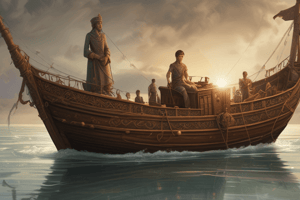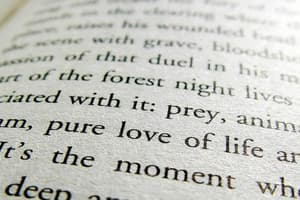Podcast
Questions and Answers
Suspension of ______ occurs when a reader is able to believe what is happening in the story, despite how unrealistic.
Suspension of ______ occurs when a reader is able to believe what is happening in the story, despite how unrealistic.
disbelief
A symbol in literary terms is something that stands for something ______ .
A symbol in literary terms is something that stands for something ______ .
else
The ______ is what the story is about, as opposed to what happens.
The ______ is what the story is about, as opposed to what happens.
theme
An unreliable narrator is a narrator who cannot be ______, for a variety of reasons.
An unreliable narrator is a narrator who cannot be ______, for a variety of reasons.
Voice is a writer’s particular ______, as well as how he or she makes the writing sound to the reader.
Voice is a writer’s particular ______, as well as how he or she makes the writing sound to the reader.
Prose is the primary style of writing used in ______, employing sentences and paragraphs.
Prose is the primary style of writing used in ______, employing sentences and paragraphs.
The protagonist is the main character of the story, most engaged in the plot and ______.
The protagonist is the main character of the story, most engaged in the plot and ______.
Psychic distance refers to how far the reader is taken inside the character's ______.
Psychic distance refers to how far the reader is taken inside the character's ______.
Realism in fiction means literal, believable, non-magical, and non-______ actions.
Realism in fiction means literal, believable, non-magical, and non-______ actions.
An active voice involves the narrator performing the actions of the ______.
An active voice involves the narrator performing the actions of the ______.
The rising action prepares the reader for the ______ of the story.
The rising action prepares the reader for the ______ of the story.
The ______ is the adversary of the protagonist.
The ______ is the adversary of the protagonist.
Chekov’s gun states that if a gun is introduced early in the story, it must ______ before the end.
Chekov’s gun states that if a gun is introduced early in the story, it must ______ before the end.
A short story traditionally has a protagonist, antagonist, rising action, climax, and ______.
A short story traditionally has a protagonist, antagonist, rising action, climax, and ______.
The climax is the highest point of tension in a ______.
The climax is the highest point of tension in a ______.
Stream of consciousness is a style of prose that reveals the narrator's thoughts as they ______.
Stream of consciousness is a style of prose that reveals the narrator's thoughts as they ______.
Direct characterization involves the writer making ______ statements about a character's personality.
Direct characterization involves the writer making ______ statements about a character's personality.
Suspense in a story is achieved when the reader wants to know what happens ______.
Suspense in a story is achieved when the reader wants to know what happens ______.
An epiphany is a moment of ______ and insight.
An epiphany is a moment of ______ and insight.
A flat character lacks enough details to seem real or ______.
A flat character lacks enough details to seem real or ______.
En medias res refers to a story that begins in the middle of a ______.
En medias res refers to a story that begins in the middle of a ______.
Foreshadowing occurs when the author leaves subtle hints of plot details throughout the ______.
Foreshadowing occurs when the author leaves subtle hints of plot details throughout the ______.
The fourth wall is the imaginary barrier between the story and the ______.
The fourth wall is the imaginary barrier between the story and the ______.
A frame/bookended story has a beginning and an end that surrounds an internal, separate ______.
A frame/bookended story has a beginning and an end that surrounds an internal, separate ______.
Freitag’s Triangle outlines a basic plot structure involving rising action, climax, denouement, and ______.
Freitag’s Triangle outlines a basic plot structure involving rising action, climax, denouement, and ______.
The grotesque in fiction uses physical traits to define a ______.
The grotesque in fiction uses physical traits to define a ______.
Imagery is the use of details that the reader can easily see, often leaving a lasting ______.
Imagery is the use of details that the reader can easily see, often leaving a lasting ______.
Indirect characterization happens when the writer reveals information about a character through their thoughts, words, and ______.
Indirect characterization happens when the writer reveals information about a character through their thoughts, words, and ______.
Magical realism is a style of writing where characters treat extraordinary events as ______ day.
Magical realism is a style of writing where characters treat extraordinary events as ______ day.
Flashcards
Active Voice
Active Voice
The voice in a story where the narrator directly performs the actions.
Allegory
Allegory
A story with a hidden meaning, often using symbolic characters and events to represent deeper ideas.
Antagonist
Antagonist
The character who opposes the protagonist, often creating conflict.
Arc
Arc
Signup and view all the flashcards
Backstory
Backstory
Signup and view all the flashcards
Chekhov's Gun
Chekhov's Gun
Signup and view all the flashcards
Climax
Climax
Signup and view all the flashcards
Concrete Detail
Concrete Detail
Signup and view all the flashcards
Foreshadowing
Foreshadowing
Signup and view all the flashcards
Breaking the Fourth Wall
Breaking the Fourth Wall
Signup and view all the flashcards
Frame/Bookended Story
Frame/Bookended Story
Signup and view all the flashcards
Freitag's Triangle
Freitag's Triangle
Signup and view all the flashcards
Genre Fiction
Genre Fiction
Signup and view all the flashcards
The Grotesque
The Grotesque
Signup and view all the flashcards
Hero's Journey
Hero's Journey
Signup and view all the flashcards
Inciting Incident
Inciting Incident
Signup and view all the flashcards
Suspension of Disbelief
Suspension of Disbelief
Signup and view all the flashcards
Symbol
Symbol
Signup and view all the flashcards
Theme
Theme
Signup and view all the flashcards
Third Person Limited
Third Person Limited
Signup and view all the flashcards
Third Person Omniscient
Third Person Omniscient
Signup and view all the flashcards
Psychic Distance
Psychic Distance
Signup and view all the flashcards
Rate of Reveal
Rate of Reveal
Signup and view all the flashcards
Realism in Fiction
Realism in Fiction
Signup and view all the flashcards
Resolution
Resolution
Signup and view all the flashcards
Rhythm in Fiction
Rhythm in Fiction
Signup and view all the flashcards
Round Character
Round Character
Signup and view all the flashcards
Scene in Fiction
Scene in Fiction
Signup and view all the flashcards
Study Notes
Active Voice and Allegory
- Active voice: Narrator performs story actions.
- Allegory: Symbolic narrative (e.g., Animal Farm).
Antagonist and Arc
- Antagonist: Story's adversary.
- Arc: Story's direction/shape/speed.
Backstory and Chekov's Gun
- Backstory: Details leading to plot.
- Chekov's gun: Introduced element needing resolution.
Climax and Concrete Detail
- Climax: Highest point of intensity.
- Concrete detail: Physically present detail.
Conflict and Credibility
- Conflict: Plot working against protagonist.
- Credibility: Story believable to reader.
Denouement and Deus Ex Machina
- Denouement: Story resolution.
- Deus ex machina: Author's hand too obvious.
Dialogue and Direct Characterization
- Dialogue: Characters conversing.
- Direct characterization: Explicit character details.
Dynamic Characters and En Medias Res
- Dynamic character: Character change.
- En medias res: Story begins in middle of plot.
Epiphany and Epistolary
- Epiphany: Moment of revelation.
- Epistolary: Story via letters/documents.
Figurative Language and First Person
- Figurative language: Comparisons.
- First person: Narrator is central character ("I").
First Person Peripheral
- First person peripheral: Narrator is central, telling another's story.
First Person Plural
- First person plural: Narrator is more than one, central character ("we").
Flat Characters and Foreshadowing
- Flat character: Lacking realistic detail.
- Foreshadowing: Subtle hints of plot details.
Fourth Wall and Frame/Bookended Story
- Fourth wall: Imaginary barrier between narrator and reader.
- Frame/bookended: Begins and ends with separate narratives.
Genere Fiction and Grotesque
- Genre fiction: Setting/characters conforming to a genre.
- Grotesque: Physical traits define characters.
Hero's Journey and Imagery
- Hero's journey: Plot structure with a character's goal.
- Imagery: Reader-engaging, visual details.
Inciting Incident and Indirect Characterization
- Inciting incident: Starts the plot/conflict.
- Indirect characterization: Character traits revealed through actions/thoughts/others' reactions.
Interior Monologue and Interpretation
- Interior monologue: Narrator's thoughts.
- Interpretation: Reader's perception of a story.
Literal Language and Literary Fiction
- Literal language: Basic, specific definition.
- Literary fiction: Focuses on language/form.
Magical Realism and Metafiction
- Magical realism: Extraordinary events as normal.
- Metafiction: Narrator/protagonist aware of story.
Minimalism and Monologue
- Minimalism: Few details, reader interpretation required.
- Monologue: Long speech by one character.
Moral Center and Passive Voice
- Moral center: Guiding principle of a story.
- Passive voice: Narrator receives actions.
Prose and Protagonist
- Prose: Main writing style.
- Protagonist: Main character.
Psychic Distance and Rate of Reveal
- Psychic distance: Reader immersion in character's mind.
- Rate of reveal: Speed of revealing story information.
Realism and Resolution
- Realism: Literal, believable events.
- Resolution: Story ending/conflict outcome.
Rhythm and Rising Action
- Rhythm: Prose flow/speed/cadence.
- Rising action: Story's increasing conflict.
Round Characters and Scene
- Round character: Detailed characters.
- Scene: Narrative section using dialogue.
Second Person and Serendipity
- Second person: Reader as central character.
- Serendipity: Coincidental occurrences.
Sensory Detail and Short Story
- Sensory detail: Appealing to senses.
- Short story: Brief fiction, typically under 10,000 words.
Showing vs. Telling and Stakes
- Showing vs. telling: Details vs. direct statements.
- Stakes: Consequences of the conflict.
Static Characters and Stream of Consciousness
- Static character: Unchanging character.
- Stream of consciousness: Character's thoughts as they occur.
Style and Subtext
- Style: Individual writer's approach to writing.
- Subtext: Implied meaning beneath explicit meaning.
Summary and Suspense
- Summary: Concise plot overview.
- Suspense: Anticipation of future events.
Symbol and Theme
- Symbol: Represents something else.
- Theme: Central idea/message of the story.
Third Person Limited and Omniscient
- Third person limited: Narrator sees details of one character.
- Third person omniscient: Narrator knows all characters' thoughts.
Tone and Universal Paradox
- Tone: Author's attitude.
- Universal paradox: True but self-contradictory statement.
Unreliable Narrator and Verisimilitude
- Unreliable narrator: Untrustworthy narrator.
- Verisimilitude: Story's believability.
Vernacular and Vivid/Continuous Dream
- Vernacular: Local language/dialect.
- Vivid/continuous dream: Immersion in the story.
Voice
- Voice: Writer's unique writing style/sound.
Studying That Suits You
Use AI to generate personalized quizzes and flashcards to suit your learning preferences.
Related Documents
Description
Test your knowledge on essential literary devices ranging from active voice to epiphany. This quiz explores key concepts that shape narratives, including antagonist roles, climax intensity, and more. Perfect for students and enthusiasts looking to deepen their understanding of literature.




